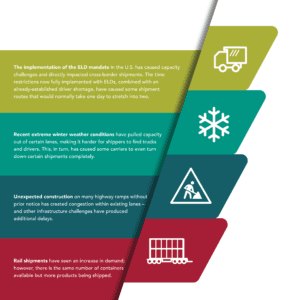You could call it the perfect capacity storm, as a number of the same challenges that U.S. domestic shippers are encountering are also impacting cross-border logistics in Mexico. In addition to factors such as the ELD mandate and recent extreme winter weather conditions, the upcoming peak produce shipping season in Mexico is set to put additional pressure on capacity and create unexpected costs for carriers and shippers alike. So, how can cross-border shippers combat some of the challenges currently accumulating in the market?
The Capacity Crunch: A Cross-Border Perspective
Capacity is tightening. According to the Wall Street Journal, “A nationwide truck shortage is forcing thousands of shippers into a tough choice: postpone all but the most important deliveries, or pay dearly to jump to the front of the line.” Trucking companies are losing the ability to choose the freight they ship – the drivers currently have the upper hand.
 Many large enterprises are facing the difficult decision of either postponing deliveries or paying a premium to get their highest-priority shipments out on time. Current spot-market prices for dry vans are up more than 20% year-over-year, and analysts expect long-term contract rates to rise by between 5% and 8% in 2018.[1] So, what’s intensifying this recent capacity crunch?
Many large enterprises are facing the difficult decision of either postponing deliveries or paying a premium to get their highest-priority shipments out on time. Current spot-market prices for dry vans are up more than 20% year-over-year, and analysts expect long-term contract rates to rise by between 5% and 8% in 2018.[1] So, what’s intensifying this recent capacity crunch?
From a cross-border perspective, peak produce shipping season in Mexico is right around the corner (occurring in late spring and early summer) and could certainly intensify these capacity challenges. The seasonal spike in demand for time-sensitive agricultural products can cause a disproportion in the flow of north and south bound freight, and the lack of trailer space available to match rising northbound demand could exacerbate the situation.[2]
Overcoming Mexican Cross-Border Challenges
Despite many of these factors contributing to the capacity crunch, there are some strategies that shippers can utilize as they move products northbound and southbound across the Mexico border. Some of the tactics we’ve seen successfully implemented during tight markets include:
- Diversifying modes of transportation: One way to create more capacity options and alleviate some of the heat from rate increases is to implement consolidation strategies at the border in Laredo. For example, full truckloads are being carried to the border, and instead of idling for as long as a week waiting for a driver, shipments can be transloaded and carried by rail.
- Collaboration and communication: Another key strategy is to keep lines of communication open between suppliers, shippers, carriers and third-party logistics providers. Being transparent and using a collaborative approach can help all parties overcome the current capacity situation by finding better, more efficient ways to move freight, understand all transportation costs and allow for more delivery window flexibility.
- Improving “preferred shipper” status: As capacity gets tighter, shippers are competing in multiple industries for both truck and container capacity – and carriers will reward efficient shippers. Ways to become a preferred shipper include improving overall shipping and receiving efficiency, extending shipping and receiving hours and avoiding pushing delivery appointments. It’s also key to meet shipping deadlines and be on time when submitting paperwork. All of this will help companies attract new carriers and retain their existing base.
- Diversifying entry points: There are more than 13,000 daily border crossings through Laredo – it’s one of the world’s most active international land gateways. And when there is congestion at this access point, many supply chains suffer and overall trade is impacted. Using alternative entry points such as El Paso, Eagle Pass, McAllen and others can help shippers reduce their exposure to both controllable and uncontrollable variables, as well as acquire access to new carriers not available in Laredo.
These strategies aren’t guaranteed capacity fixes, but they can help make capacity more readily available and ultimately help shippers improve transit times, overcome challenges at the border and increase overall operational savings.
[1] https://www.wsj.com/articles/a-shortage-of-trucks-is-forcing-companies-to-cut-shipments-or-pay-up-1516789800
[2] https://www.joc.com/trucking-logistics/ltl-shipping/truck-capacity-%E2%80%98imbalance%E2%80%99-slows-us-mexico-freight_20171109.html
 Carlos Godinez is Commercial and New Business Director Mexico for Transplace. In his role Carlos is responsible for new commercial development and leading the sales team in country offering all Transplace products, as well as responsible for P&L management, in-country leadership, profitability growth, business and execution strategy of the recently created Intermodal division, branded under Celtic International, one of the largest Intermodal Marketing Companies (IMCs) in the industry. Godinez has a Bachelor in International Business by the ITESM-Monterrey campus; international bachelor studies in the University of Wisconsin-Stout; a diploma in Project Management by the ITESM-Mexico City campus; and more recently an MBA in Global Businesses by the Thunderbird School of Global Management, at Glendale, AZ; in partnership with the ITESM.
Carlos Godinez is Commercial and New Business Director Mexico for Transplace. In his role Carlos is responsible for new commercial development and leading the sales team in country offering all Transplace products, as well as responsible for P&L management, in-country leadership, profitability growth, business and execution strategy of the recently created Intermodal division, branded under Celtic International, one of the largest Intermodal Marketing Companies (IMCs) in the industry. Godinez has a Bachelor in International Business by the ITESM-Monterrey campus; international bachelor studies in the University of Wisconsin-Stout; a diploma in Project Management by the ITESM-Mexico City campus; and more recently an MBA in Global Businesses by the Thunderbird School of Global Management, at Glendale, AZ; in partnership with the ITESM.

















Leave a Reply